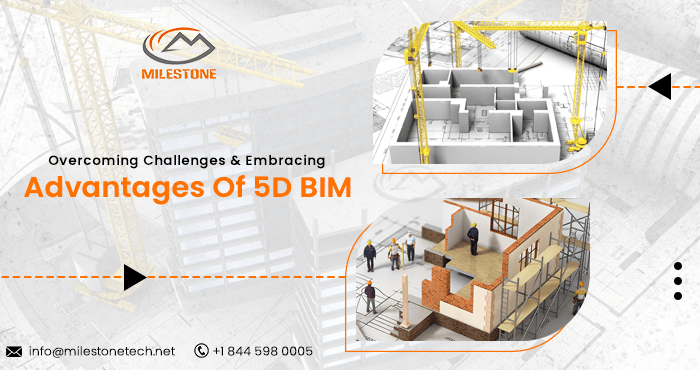Overcoming Challenges and Embracing Advantages of 5D BIM
Contents |
[edit] Introducing 5D BIM
In the ever-evolving landscape of construction services, the integration of Building Information Modeling (BIM) has marked a paradigm shift. Among the various dimensions of BIM, the emergence of 5D BIM stands out as a revolutionary advancement, promising to redefine the way projects are conceived, executed, and managed. This article explores the challenges posed by 5D BIM implementation and how the industry can harness its advantages to propel itself into a new era of efficiency and innovation.

[edit] Understanding 5D BIM
Before delving into the challenges and advantages, it's crucial to grasp the essence of 5D BIM. Unlike traditional 3D and 4D BIM, which focus on the physical and temporal aspects of a project, 5D BIM adds a financial dimension to the digital representation. It seamlessly integrates cost data with the 3D model and construction schedule, providing a comprehensive view of the project's lifecycle.
[edit] Challenges of implementing 5D BIM
1. Technological Adaptation:
The adoption of 5D BIM requires a robust technological infrastructure. construction firms may face challenges in upgrading their systems, training their workforce, and ensuring compatibility with existing processes.
2. Data Standardization:
A significant hurdle is the standardisation of data across various stakeholders. With multiple parties involved in a construction project, ensuring a unified data standard becomes essential for effective collaboration and information exchange.
3. Cost Estimation Accuracy:
While 5D BIM promises enhanced cost estimation capabilities, achieving accuracy in cost projections demands meticulous data input and continuous updates. Inaccuracies in the initial stages can have cascading effects on the entire project.
[edit] Embracing the advantages of 5D BIM
1. Improved Decision-Making:
The integration of cost data with the 3D model empowers stakeholders to make informed decisions. Project managers can assess the financial implications of design changes in real-time, leading to more efficient and cost-effective choices.
2. Enhanced Collaboration:
5D BIM fosters collaboration among diverse project participants. Architects, engineers, contractors, and financial experts can work together seamlessly, reducing the risk of miscommunication and streamlining the decision-making process.
3. Efficient Resource Management:
The ability to visualise and analyse cost implications aids in efficient resource management. With a clear understanding of the financial aspects, project teams can optimise resources, allocate budgets effectively, and mitigate the risk of overspending .
[edit] The future of 5D BIM
As the construction industry continues its journey toward digital transformation, the role of 5D BIM is poised to become even more pivotal. This section of the article will explore emerging trends, such as the integration of artificial intelligence and machine learning with 5D BIM, offering a glimpse into the future of construction services. As technology continues to evolve, 5D BIM is expected to become the industry standard. The integration of artificial intelligence and machine learning will further automate processes and enhance decision-making capabilities. The development of cloud-based platforms will improve accessibility and collaboration across teams and projects. Additionally, the emergence of virtual reality (VR) and augmented reality (AR) will revolutionise the way projects are visualised and constructed, enhancing safety and efficiency on site.
[edit] Conclusion
In conclusion, overcoming the challenges and embracing the advantages of 5D BIM is a crucial step for construction services to stay competitive in a rapidly evolving environment. By addressing technological, data, and estimation challenges head-on, industry professionals can unlock the full potential of 5D BIM, ushering in a new era of efficiency, collaboration, and innovation. The future of construction is not just about erecting structures but about building them smarter and more cost-effectively through the power of 5D BIM.
--Engineering Design & BIM Services
[edit] Related articles on Designing Buildings
- As-built drawings and record drawings.
- As-installed drawing.
- Asset information model.
- Benefits of manufacturer-created BIM models.
- BIM dimensions.
- BIM dimensions, maturity and levels of development.
- BIM execution plan.
- BIM for dummies - an interview.
- Construction drawing.
- Construction Operations Building Information Exchange (COBie).
- CIC BIM Protocol.
- Concept drawing.
- Common data environment.
- Component drawing.
- Design drawings.
- Detail drawing.
- Drawing board.
- Elevations.
- Floor plan.
- General arrangement drawing.
- Industry Foundation Classes.
- Level 2 BIM.
- Level 3 BIM.
- Level of detail.
- Open data.
- PAS 1192-2:2013.
- PAS 1192-3:2014.
- Production drawing.
- Project information model.
- Scale drawing.
- Section drawing.
- Shop drawings.
- Site layout plan.
- Site plan.
- Symbols on architectural drawings.
- Technical drawing.
- Title plan.
- Types of building models.
- Types of drawings for building design.
- Types of paper.
- Types of projection.
- Concept drawing.
- Component drawing.
- Visualisation.
BIM Directory
[edit] Building Information Modelling (BIM)
[edit] Information Requirements
Employer's Information Requirements (EIR)
Organisational Information Requirements (OIR)
Asset Information Requirements (AIR)
[edit] Information Models
Project Information Model (PIM)
[edit] Collaborative Practices
Industry Foundation Classes (IFC)






